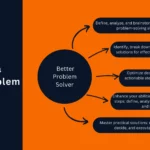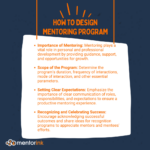
Mentoring goes beyond offering advice. It is a meaningful and evolving relationship that supports both personal and professional growth. Mentoring process can shape career paths, shift perspectives, and unlock opportunities that might otherwise stay hidden. But a well-designed mentoring process does not just happen. It takes intention, a clear structure, and real commitment from both mentor and mentee. To truly benefit from this valuable connection, it is important to understand its purpose and the key steps that make the process effective. Before diving into what is mentoring process you can also learn more about what is mentoring. “The Five W’s of Mentoring” can give you valuable informations about mentoring.
What Are Fundamental Mentoring Functions?
At its core, mentoring serves two major functions: career-related support and psychosocial support. These two elements work together to build a relationship that is both productive and personally enriching.
Career Functions
You can focus on helping the mentee navigate professional challenges, develop skills, and advance within their chosen field. This might include sponsorship, coaching, protection, exposure to key networks, and providing challenging assignments that foster growth. A mentor may help the mentee craft a strategic career path, offer feedback on performance, or introduce them to influential people in the industry. Roles of mentors in sector can be varied. In order to learn more about career functions of mentors you can look our blog content: “Mentoring in Sectors.”
Psychosocial Functions
Psychosocial functions, on the other hand, support the mentee’s emotional and psychological development. This includes building self-confidence, providing encouragement, and serving as a role model. These aspects help the mentee feel valued, understood, and motivated, which are critical for long-term personal and professional resilience.
The balance between these two functions often shifts over time. Early in the relationship, career guidance might dominate, but as trust builds, the psychosocial aspect becomes more prominent. Mentoring that lacks one or both of these functions is unlikely to be long-lasting or deeply impactful.
How Is the Mentoring Process Structured?
The mentoring process unfolds in distinct stages, each with its own goals, challenges, and activities. While every relationship is unique, most follow a recognizable arc from initiation to closure. Knowing what to expect at each step can help both mentor and mentee navigate the relationship with clarity and intention.
Preparation of Mentoring Process
Before the mentoring relationship even begins, preparation is critical. Both parties need to clarify their motivations and expectations. For the mentor, this means reflecting on why they want to be a mentor, what they hope to contribute, and how much time they can commit. For the mentee, preparation involves understanding what they need from a mentor and identifying areas for growth.
In formal mentoring programs, this stage often includes orientation sessions, training, or assessments to help match mentors with mentees based on interests, goals, or experience. Informal mentorships might emerge more organically, but even then, taking the time to align expectations at the outset improves the odds of success.
Initiation of Mentoring Process
This is where the relationship officially begins. Initial meetings are used to establish rapport, agree on goals, and set ground rules for the partnership. Both parties need to discuss how they will communicate, like in-person meetings, video calls, and emails; how often they will meet; and what confidentiality will look like.
This stage is about building trust and laying the groundwork for open, honest conversations. It’s also the time to define success: What does a “successful” mentoring relationship look like to each party? Getting clear on these fundamentals early on avoids confusion and disappointment down the line.
Cultivation of Mentoring Process
This is the longest and most active stage of the mentoring process. Here, the mentor begins to provide the agreed-upon support and guidance, while the mentee starts applying feedback, reflecting on progress, and developing new skills or perspectives.
In this phase, career and psychosocial functions come fully into play. The mentor might challenge the mentee to step outside their comfort zone or provide strategic advice on career decisions. At the same time, they offer encouragement, listen without judgment, and celebrate wins—big or small.
Regular communication is crucial during this stage. Mentoring relationships tend to lose momentum when meetings become irregular or unfocused. Both mentor and mentee must stay committed and responsive, continually refining their approach based on what’s working and what’s not.
Transition or Separation
Eventually, the active mentoring phase comes to a natural close. This could be due to the mentee achieving their goals, changes in job roles, or the completion of a formal mentoring program. Ending the relationship does not mean the connection is lost but it does mean shifting gears.
During this phase, it is crucial to reflect on what was accomplished and acknowledge the contributions of both parties. This may include a final meeting to discuss lessons learned and how the mentee intends to apply them moving forward. Even if the formal structure is ending, a good closure reinforces the relationship’s value and opens the door for future collaboration.
How Are Mentor-Mentee Relationships Built in Mentoring Process?
Successful mentoring relationships do not just happen, but they are built step by step through mutual effort, respect, and communication. Understanding how these relationships develop helps ensure they are not only effective but also rewarding.
Establishing Trust Between Mentor and Mentee Relationships
Trust is where it all starts. Without it, open conversations and real growth just will not happen. It is built over time by showing up, keeping things private, listening closely, and genuinely caring. If a mentor often cancels or breaks promises, it chips away at their credibility. On the flip side, if a mentee brushes off feedback or doesn’t take initiative, the relationship can stall before it really begins.
Clarifying Roles Between Mentor and Mentee
Everyone needs to be on the same page. A mentor is not there to be a boss, a therapist, or a constant cheerleader. They are more of a guide, someone to bounce ideas off and even challenge you when needed. Mentees, meanwhile, are responsible for their own growth. That means showing up prepared, steering conversations when needed, and following through on next steps. Understanding the relationship between mentor and mentee can help you to clarify roles.
Communication and Feedback
Consistent communication keeps things running smoothly. Regular check-ins help ensure everything stays on track and give both people a chance to adjust if needed. Feedback shouldn’t just go one way. Mentors can learn a lot from their mentees too.
Good feedback is clear, timely, and focused on what someone does, not who they are. And it should go both ways. Mentors should be open to suggestions, and mentees should feel comfortable sharing any concerns or hurdles they’re facing.
Managing Conflict and Misalignment
Even strong mentoring relationships can hit bumps. Maybe advice does not sit right or meetings get missed. It is important to talk about problems openly and respectfully. Letting issues slide just weakens the connection.
Setting ground rules early, like how often to meet, what goals to focus on, and where boundaries lie, can help sort things out quickly when issues pop up. And if it is clear the relationship isn’t working anymore, it’s okay to move on respectfully.
Evolving the Relationship
Some mentorships shift over time. They might grow into peer support, friendships, or future collaborations. Others might pause and pick back up later. Being open to change allows both people to keep gaining value from the connection even as things evolve.


